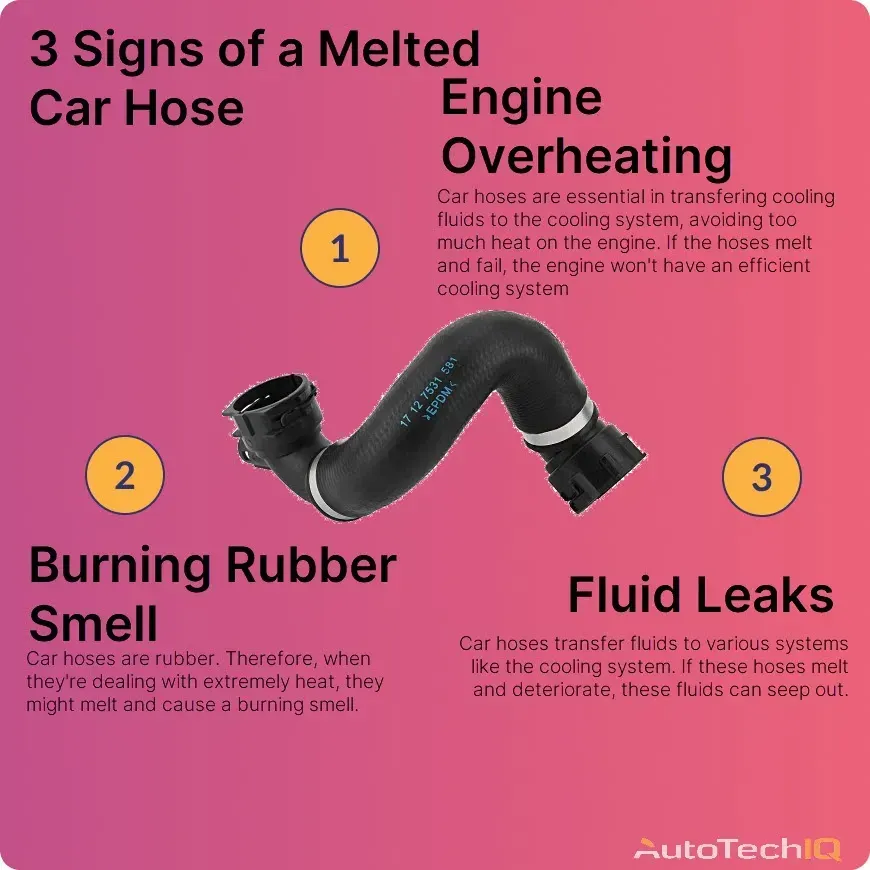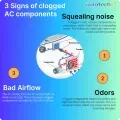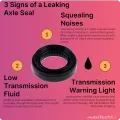

The main sign of a melted car hose is a burning rubber smell. Car hoses are typically rubber, and suffering excessive heat burns them, causing the smell.
A vehicle has many hoses belonging to many systems, like the A/C, radiator, fuel, air intake, etc. In some cases, these hoses can dislocate and loosen up, becoming at risk of touching or even banging car parts they’re not supposed to.
-
Positioning: Hoses are typically clung someplace in the vehicle designed for them. This position is commonly away from hot components to avoid contact damage. However, hoses can slip out of place due to impact, wear, etc. Some hoses usually stay behind a heat shield, which protects them from heat sources.
When the vehicle runs, it’ll heat internal components, and a loose rubber hose has the risk of rubbing against hot car parts it’s not supposed to. Consequently, the rubber hose might burn and melt.
-
Safety: A melting hose can mean a fire hazard, depending on where the melted material can land and how flammable it is. Plus, hoses have essential functions in a vehicle, for example, a brake booster vacuum hose is needed to ensure you’re braking efficiently, so losing it means brake risks. Additionally, melted rubber can release toxins that are not appropriate for a person to breathe.

A burning rubber smell
The burning rubber smell results from the melting/burning of a loose rubber hose or belt rubbing against a hot car part. Hence, many of your car's rubber parts, such as coolant hoses, steering hoses, timing belts, and accessory drive belts, might have something to do with it.
Acting early is crucial since rubber can deteriorate under high heat and affect related parts. So, if you notice the smell of burning rubber, safely pull over; it’s not recommended to drive without knowing the level of damage.
Here are some of the possible rubber hoses at risk of melting:
-
Radiator Hoses: These hoses carry coolant between the engine and the radiator and are exposed to high temperatures. They are typically made of heat-resistant rubber but can still melt if the cooling system fails or if the engine overheats.
-
Heater Hoses: Heater hoses carry hot coolant to the heater core, which then heats the interior of the vehicle. These hoses are also exposed to high temperatures and can melt if they come into contact with a hot engine component.
-
Fuel Hoses: Hoses that carry fuel from the fuel tank, through the fuel filter to the engine can also be affected by heat. Leaking fuel hoses can be a fire hazard.
-
Vacuum Hoses: These hoses create vacuum pressure for various systems in the vehicle, such as the brake booster or the emissions control system. Vacuum hoses can melt if they come into contact with hot engine components.
-
Air Intake Hoses: Hoses that connect the air filter to the throttle body or intake manifold can also be affected by heat, especially if the engine is turbocharged or supercharged.
Engine overheating
Hoses have various roles in a vehicle. A radiator hose moves coolant to the engine to avoid overheating and keep the car at a safe working temperature. Therefore, many hoses connect to the water pump, keeping a safe cooling flow. However, a melted radiator hose can lead to coolant leaks, losing its cooling efficiency and causing the engine to overheat.
Engine overheating can result in engine damage and potential breakdown, which can be dangerous if it occurs while driving, especially in traffic. You can also keep an eye on the dashboard for any of these warning lights:
Other common signs
Here are other common signs that some of your vehicle’s hoses might be melting/burning:
-
Fluid leaks
-
Performance loss
-
Warning lights
-
Strange noises
-
A/C and Heater malfunction
Possible fixes
-
Radiator Hoses Replacement: A melting radiator hose needs an immediate fix to restore the vehicle’s cooling system.
-
Bypass Hoses Replacement: A melted bypass hose results in a loss of coolant, which can cause the engine to overheat.
-
Heater Hoses Replacement: Melted heater hoses need replacement to restore the heater’s functionality and provide comfort inside the cabin during cold weather.
-
Cooling System Flush: A melted radiator hose might contaminate coolant. Therefore, a coolant system flush is a safe step to avoid any contamination.
-
Cooling System Fluid Exchange: Melted hoses might result in coolant loss and contamination. It’s best to exchange the fluid and ensure proper coolant levels.
Frequently Asked Questions
How often should car hoses be replaced?
While manufacturers recommend replacing car hoses every four years, inspection is key. Factors like high mileage, extreme weather, and hose material can impact their lifespan. Regularly check for signs of wear like cracks, bulges, or brittleness in an old hose. If you notice anything suspicious or are unsure about the condition of your hoses, consult a mechanic for a professional assessment to avoid potential breakdowns.
Can I drive my car with a broken hose?
Not recommended. A broken hose can leak vital fluids, lead to overheating, or cause reduced performance. Keeping your engine running in this situation can damage it further or even start a fire. Play it safe - if you suspect a broken hose, get your car towed to a mechanic to avoid further problems.
Can I drive with a faulty coolant hose?
Driving with a faulty coolant hose is very risky. It can leak coolant, leading to overheating which can severely damage your engine. Pull over safely if you notice signs of a coolant hose problem and have your car towed to a mechanic to avoid expensive repairs.
Other news
-
Car is Squealing When Driving

-
What is Preventative Maintenance and What Are The Benefits of it?

-
JobViewIQ - DVI Process Training - Part of the Auto Care Alliance Benefits

-
7 Signs of Clogged AC Components

-
How Much Does a Transmission Fluid Change Cost?

-
7 Signs of a Leaking Axle Seal

-
8 Signs of a Bad Brake Pad
